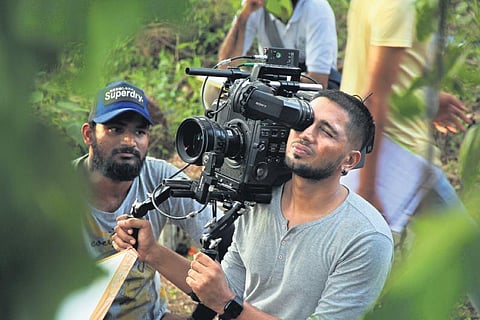

When cinematographer Sreeraj Raveendran told us last year about the existence of a little project he co-wrote called Thinkalazhcha Nishchayam, little did we know that it would turn out to be a cracker of a film that would surpass all expectations.
The tremendous reception following its IFFK-screening last year was an indicator of its exceptional quality, which was there for all to see, at last, when it premiered on SonyLIV last Friday. The behind-the-scenes story, recounted by Sreeraj, is as fascinating as that of any big, VFX-laden film.
When Sreeraj and director Senna Hegde set out to do the film, the objective was to make a "fun-packed, relatable commercial entertainer" that was at once sensible and expressed its politics without being preachy. "We envisioned a comedy-drama with a vintage flavour narrated through a modern lens," says Sreeraj, who, along with his camera, behaved like an onlooker observing things from afar and then going closer as things got increasingly intense. Both Senna and Sreeraj got on the same page when it came to the film’s visual style. The former wanted the camera to be in motion, even when it stays in the same position.
"He didn't want any dead frame or many cuts. We were instead keenly focusing on the choreography of actors’ movements and ensuring that the continuity of the background and foreground activities were well-coordinated," continues Sreeraj, adding that they didn't use drones or tracking shots either as they feared that these could be potential distractions too.
The team had initially considered mainstream actors, but Senna's intuition pointed them towards a relatively subversive direction that eventually worked in their favour. "Initially, there was the concern of this approach giving everyone the impression of a 'festival film', but I grew confident after seeing the actors. I thought, 'Hey, this sounds like a cool idea, after all'. We were casting up until two days before the shoot," recalls Sreeraj.
"The biggest advantage of casting fresh faces is that the audience wouldn’t be able to predict how the characters are going to react in a given situation whereas, with familiar actors, people have preconceived notions," he adds.
Were the dialogues initially written in the Kanhagad dialect? "No," he replies. "We just wrote the content we wanted and asked the actors to do it in their dialect in the way they would normally do. We didn't give the script to anyone. Having Rajesh Madhavan, our creative director, also helped as he was from that area. And shooting it in sync sound was helpful because that gives the actors much freedom. Besides, Senna doesn’t believe in dubbing. He believes that if an actor gave 90-95 per cent on the set and later when they dub for the same performance, it becomes 85 per cent."
Principal photography took 23 days at a house in an elevated spot in Kanhagad. The team sought one with steps where no vehicle except a two-wheeler can reach, a choice made during the writing stage. "It made more sense while considering the few conflicts popping up later in the film. But there was a slight snag. This house looked great from the outside, but its limited interior space posed a challenge. He is a no-nonsense guy; he is direct when expressing his view. We eventually figured out how to shoot in the same house," says Sreeraj, who suggested using the interiors of another house, but Senna wasn’t one to encourage it.
One of the clever decisions made was the use of anamorphic lenses that cover more space. "There were two reasons for using them. 1) To avoid congestion, and 2) To give the film a slightly vintage look. We used Hawk anamorphics to create that effect. It has its cons like distortions and other aberrations, but we used those to our advantage because the yesteryear films had them too. But one thing we didn’t want was flares which we tried our best to avoid. Flares work well in a thriller, not in something like this," he says.
As for lighting up this limited space, Sreeraj used around 40 smart bulbs (controlled via a smartphone) inside China balls at the top to achieve a uniform and necessary visibility. "Normally, it takes 30-45 mins to light up a scene, but these bulbs helped us move faster. There are no complications with this setup. The characters can move without limitations. I only have to give instructions to the assistants about the configuration and the necessary adjustments when a character moves from one room to another," he explains.
Sreeraj is also proud of maintaining a consistent colour palette throughout the film, a rarity in filmmaking. "We took a lot of effort to ensure that the costumes and backgrounds worked harmoniously from beginning to end. We followed colour psychology in certain places. I couldn’t even compromise on the colour of the panthal because if I didn’t get that particular colour, it would’ve made things quite complicated," he laughs.
Sreeraj has a favourite moment in the film. It's when the character Vimala, played by debutant Mini Shine, becomes the cause for much mayhem when she brings up past secrets in the film’s penultimate scene. "I got goosebumps in that scene. It was so surreal seeing the actors enacting a real scuffle, with minor cuts and scratches and everything. That’s the privilege of being a cinematographer - unlike a director or any other crew member, you get to see magic up close," he says.